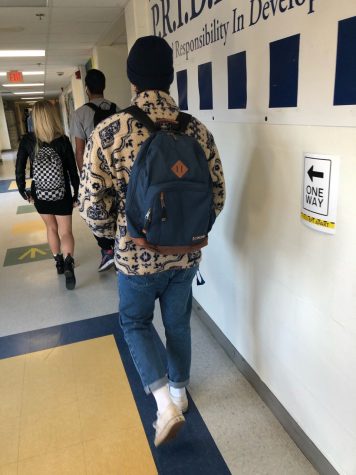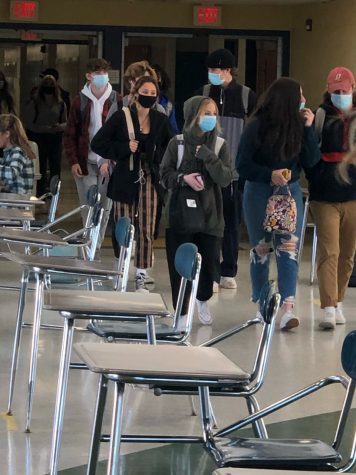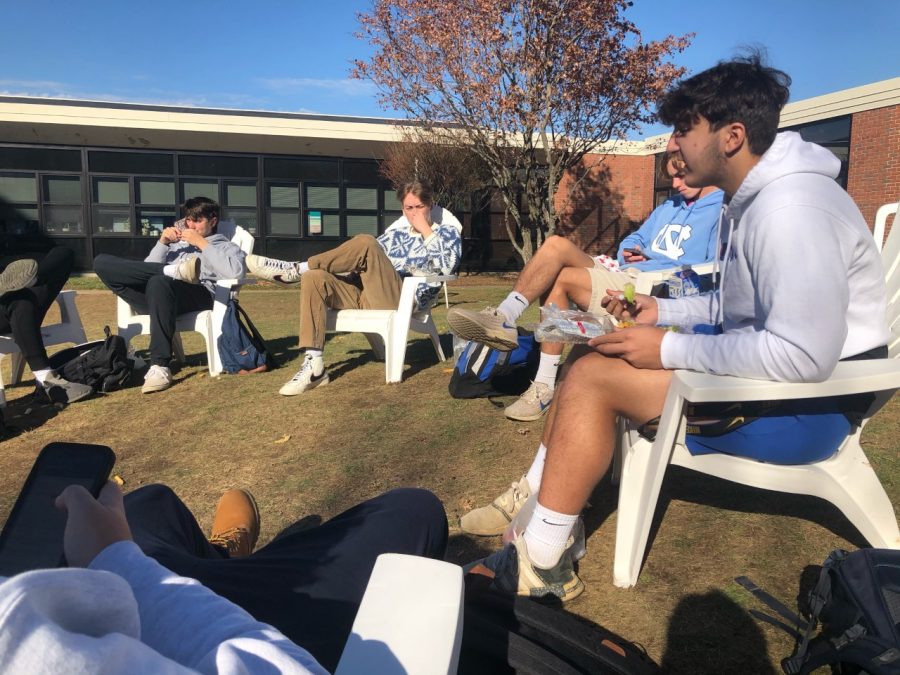Back to school takes on new routines in pandemic
When the weather has been nice, seniors at Lewis Mills get to eat outside, but they must make sure to stay socially distant.
December 8, 2020

March 12th, 2020: A date that every student across the United States knows the significance of. Now 8 months later and no end in sight, normalcy is a thing of the past, as we try to learn during a global pandemic. The coronavirus first reached U.S. soil in January of 2020, and the threat has loomed large ever since. Through the summer, every student had the same question stirring in their minds: are we going back to school this fall, and how are we going to do that? For Lewis S. Mills High School planning for the reopening of schools began early in the summer.
“It’s been an all-summer endeavor,” said Chris Rau, the school’s principal. Plans included hallways that all flow in the same direction (like that of a “lazy river”), limited seating in the cafeterias, and social distancing efforts throughout the entire school. These changes have dramatically affected every single student and faculty member in some way whether in the school, out of school, or on a sports field, and the effects are visibly evident in more ways than one.
“Students are excited to be back,” Rau mentioned enthusiastically in an early fall interview. Schools opened in a hybrid format on Sept. 1st. Half of the school learned from home while the other half was in school, and the two cohorts alternated every day from Tuesday to Friday with a full day of distance learning on Mondays. Students surprisingly had “no complaints,” according to Rau. Even though Rau had not heard any complaints, students and teachers still expressed some concerns with the sudden change of plans.
“It’s been really hard to get on a normal schedule while learning half at home and half at school,” Lewis Mills Senior Sean Polinsky said of the unconventional start to school. For Polinsky, it was a “very weird” first few weeks. It proved challenging to adapt to the hybrid schedule, as he prefers learning in school with the teacher as an immediate resource.
For Lewis Mills French teacher Laura Faga, planning for this school year was even harder than in years past.
“I have to move a little slower with my classes and prioritize teaching more important things,” she said in the first weeks of school.
Faga went above and beyond to stay organized and make sure her students can successfully learn, despite challenges such as not seeing all of her students every day, or not necessarily knowing what her teaching plans will be like in the future.
On Sept. 28, Mills had almost all its 707 students return to the building full-time, except for a group of students who opted to stay home and learn online. Both students and faculty have had a wide variety of opinions about coming back.
Heading into the full, in-person return, Rau felt very confident with the idea of all students back in the building.

“I’m feeling better and better each day about doing this long term,” Rau stated positively as the school prepared to make the instructional switch.
Faga prefers to teach in-person, as lots of teacher would, but she was definitely “nervous about having lots of kids in the building at once” she said as the transition from hybrid to full, in-person learning approached.
Students tend to be very resistant to change, so it’ll be an interesting experience to see how Mills students can adapt to their education changing every day.
Even with the immense changes in the classroom, students and faculty faced just as many changes outside of the school, primarily with the changes in fall sports plans. On Sept. 4, the CIAC announced the cancellation of high school football for the fall, and this had a massive impact on Polinsky, who is a captain of the Lewis Mills football team.
“I can’t imagine my life without football,” Polinsky preached passionately. According to Polinsky, the team had been working tirelessly for the entire 8-month offseason, and it was devastating to see the season ripped away from them. Losing the Mills season has “added even more stress on top of academics” for Polinsky.
In recent weeks, a private league was approved, and both Polinsky and every Mills football player was hoping a season could still happen.
Jay Pelchar, the athletic director at Lewis Mills, has worked at Mills since 2002. Pelchar is “frustrated” with the entire situation, but he has a very positive attitude towards the future: “We’ve got to stay hopeful, but realistic too.”
Pelchar understood that a positive attitude was necessary, but that schools’ athletic goals cannot be unrealistic in making it through this pandemic.
For Faga, her summer plans were “completely ruined” because of the coronavirus: “I was supposed to have the best summer of my life and travel everywhere, and I didn’t even leave Connecticut!” It was very upsetting for Faga, her husband, and three children this summer, being cooped up in their houses and not being able to travel.
Needless to say, there have been some bumps in the road along the way. Near the end of October, a student tested positive for the coronavirus. Out of an abundance of caution, the school removed over 120 students and staff from the building for two weeks to quarantine. Toward the end of that two-week period, two faculty and staff members tested positive, which also removed an additional set of students and faculty from the building for two weeks.
With the holiday break less than a couple weeks away, Lewis Mills is still in school full-time, but the school has opted to switch to full distance learning starting December 11th. This will give students and their families a chance to quarantine to prevent sickness before the holidays. If everything goes well, students and teachers will be back in school on January 4th of 2021.
Whether in the classroom, outside of school, or on the football field, coming back to school in the fall has had a long lasting impact on not only Mills students and faculty, but the entire country, and the entire world.
